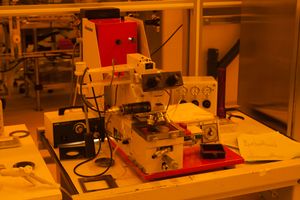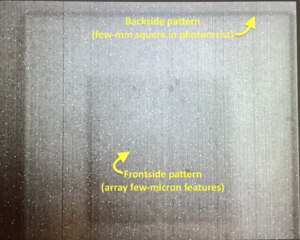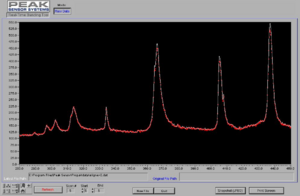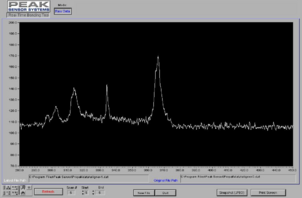Difference between revisions of "Suss Aligners (SUSS MJB-3)"
(→IR Aligner: removed hammamatsu) |
|||
| (20 intermediate revisions by 5 users not shown) | |||
| Line 1: | Line 1: | ||
| − | {{ |
+ | {{tool2|{{PAGENAME}} |
|picture=SussAligner.jpg |
|picture=SussAligner.jpg |
||
|type = Lithography |
|type = Lithography |
||
| − | |super= |
+ | |super= Lee Sawyer |
| + | |super2= Don Freeborn |
||
| − | |phone=(805) |
+ | |phone=(805) 893-2123 |
|location=Bay 6 |
|location=Bay 6 |
||
| − | |email= |
+ | |email=lee_sawyer@ucsb.edu |
|description = Mask Aligner - MJB 3 UV400 |
|description = Mask Aligner - MJB 3 UV400 |
||
|manufacturer = Karl Suss America |
|manufacturer = Karl Suss America |
||
|materials = |
|materials = |
||
}} |
}} |
||
| − | = |
+ | ==About== |
| + | We have two high-performance mask aligners for contact exposure processes. They are manual mechanical systems alignment, contact/proximity, with exposure shuttered by a timer. The resolution (depending on contact mode, optics and exposure wavelength and "operator technique") is into the submicron region. (See descriptions for our "Std." and "IR" units). |
||
| − | We have three high-performance mask aligners for contact exposure processes. The resolution (depending on contact mode, optics and exposure wavelength and "operator technique") is into the submicron region. (See descriptions for our "L", "R" and "IR" units). Our left and IR units are configured for the near-UV window (365 and 405 nm). Using a filter, these two systems can be configured for I-line (350 nm) only, assisting in resolution. All units have the "vacuum contact" option extending resolution to ~0.7 microns. Higher resolution optic systems that can be supplied by Suss are given below. The standard soft and hard contact modes of mechanical and pneumatic pressure respectively, give resolution to ~1 micron. Exposures can be done on substrates from small "piece parts" of less than 1 cm square to substrates of 3 inch diameter or square. Special black chucks may be used for transparent materials. For backside alignment through opaque materials such as Si or GaAs, our IR aligner can be used and is described below. Masks up to 4 inches in size can be used although only 3” x 3” of this area is usable. A 4” wafer can be exposed with the system. However, only 3” x 3” will be exposed on the wafer and vacuum mode is unavailable. |
||
| + | |||
| + | Our units are configured for the near-UV window (365 and 405 nm). All units have the "vacuum contact" option extending resolution to ~0.7 microns. Higher resolution optic systems that can be supplied by Suss are given below. The standard soft and hard contact modes of mechanical and pneumatic pressure respectively, give resolution to ~1 micron. |
||
| + | |||
| + | Exposures can be done on substrates from small "piece parts" of less than 1 cm square to substrates of 3 inch diameter or square. Masks up to 4 inches in size can be used although only 3” x 3” of this area is usable. A 4” wafer can be exposed with the system. However, only 3” x 3” will be exposed on the wafer and vacuum mode is unavailable. |
||
| + | |||
| + | ====Backside Alignment==== |
||
| + | On the Standard MJB-3, special black chucks may be used for optically transparent materials, allowing you to view through the wafer. |
||
| + | |||
| + | For backside alignment through opaque materials such as Si or GaAs, our IR aligner has backside infrared illumination (halogen bulb) through these black chucks. A Hammamatsu IR camera is installed to view the infrared image. |
||
| + | |||
| + | Using a filter, the IR system can be configured for I-line (350 nm) only, assisting in resolution. |
||
| + | |||
| ⚫ | |||
| ⚫ | |||
*Wafer size: 3" max. for vacuum mode; 4” for soft contact (3” x 3” exposure area) |
*Wafer size: 3" max. for vacuum mode; 4” for soft contact (3” x 3” exposure area) |
||
*Substrate size: 3" x 3" max. |
*Substrate size: 3" x 3" max. |
||
*Wafer / substrate thickness: 0-4.5 mm |
*Wafer / substrate thickness: 0-4.5 mm |
||
*Exposure optics: |
*Exposure optics: |
||
| − | ** |
+ | **Standard unit (Aligner #1): 350-450 nm/200 W mercury lamp |
| − | **Right unit: 350-450 nm/200 W mercury lamp |
||
**IR unit: 280-450 nm/200 W mercury lamp (can filter to 350 nm) |
**IR unit: 280-450 nm/200 W mercury lamp (can filter to 350 nm) |
||
*Additional manufacturer options (none installed on our systems): |
*Additional manufacturer options (none installed on our systems): |
||
| Line 28: | Line 40: | ||
**±3% over 2" diameter |
**±3% over 2" diameter |
||
**±5% over 3" diameter |
**±5% over 3" diameter |
||
| + | |||
| ⚫ | |||
| + | ===IR Aligner=== |
||
| ⚫ | |||
| + | |||
| ⚫ | |||
| + | *Backside illumination with halogen bulb & transparent chuck |
||
| ⚫ | |||
| + | *Infrared camera and computer for imaging. |
||
| ⚫ | |||
| + | *Through-wafer alignment and/or inspection. |
||
| + | |||
| + | [[File:IR Alignment check 01 - crop.png|alt=Screenshto of IR camera showing front-to-back alignment|none|thumb|MJB-IR front-to-back alignment check through Silicon substrate, with few-micron etched features on the front, aligned to few-mm photoresist pattern on the backside.]] |
||
| + | <br /> |
||
| ⚫ | |||
| ⚫ | |||
| ⚫ | |||
| ⚫ | |||
| ⚫ | |||
| + | |||
| + | *[https://wiki.nanotech.ucsb.edu/wiki/images/d/de/MJB_3_SOP.pdf MJB-3 Standard Operating Procedure] |
||
| + | *[https://wiki.nanotech.ucsb.edu/w/images/7/70/MJB_3_IR_Camera_SOP_Rev_B.pdf MJB-3 IR Camera Operation] |
||
| + | *[https://wiki.nanotech.ucsb.edu/w/images/1/11/MJB_3_IR_Alignment_Mode_Conversion.pdf MJB-3 IR Alignment Mode Conversion] |
||
| + | *[[Photomask Ordering Procedure for UCSB Users]] - see this page for how to submit your order into the purchasing system. |
||
| + | |||
| + | ===CAD Files=== |
||
| + | |||
| + | *Male/female alignment marks (GDS): [[Media:MA6-FrontBack AlignMarks only.gds|MA6-FrontBack_AlignMarks_only.gds]] |
||
| + | |||
| + | ==Recipes== |
||
| + | |||
| + | *Recipes > Lithography > Photolithography Recipes > [[Contact Alignment Recipes#Suss Aligners .28SUSS MJB-3.29|'''<u>SUSS MJB-3</u>''']] |
||
| + | **''Starting recipes for various I-Line photoresists, positive and negative.'' |
||
Latest revision as of 12:07, 1 March 2024
| ||||||||||||||||||||||||||
About
We have two high-performance mask aligners for contact exposure processes. They are manual mechanical systems alignment, contact/proximity, with exposure shuttered by a timer. The resolution (depending on contact mode, optics and exposure wavelength and "operator technique") is into the submicron region. (See descriptions for our "Std." and "IR" units).
Our units are configured for the near-UV window (365 and 405 nm). All units have the "vacuum contact" option extending resolution to ~0.7 microns. Higher resolution optic systems that can be supplied by Suss are given below. The standard soft and hard contact modes of mechanical and pneumatic pressure respectively, give resolution to ~1 micron.
Exposures can be done on substrates from small "piece parts" of less than 1 cm square to substrates of 3 inch diameter or square. Masks up to 4 inches in size can be used although only 3” x 3” of this area is usable. A 4” wafer can be exposed with the system. However, only 3” x 3” will be exposed on the wafer and vacuum mode is unavailable.
Backside Alignment
On the Standard MJB-3, special black chucks may be used for optically transparent materials, allowing you to view through the wafer.
For backside alignment through opaque materials such as Si or GaAs, our IR aligner has backside infrared illumination (halogen bulb) through these black chucks. A Hammamatsu IR camera is installed to view the infrared image.
Using a filter, the IR system can be configured for I-line (350 nm) only, assisting in resolution.
Detailed Specifications
- Wafer size: 3" max. for vacuum mode; 4” for soft contact (3” x 3” exposure area)
- Substrate size: 3" x 3" max.
- Wafer / substrate thickness: 0-4.5 mm
- Exposure optics:
- Standard unit (Aligner #1): 350-450 nm/200 W mercury lamp
- IR unit: 280-450 nm/200 W mercury lamp (can filter to 350 nm)
- Additional manufacturer options (none installed on our systems):
- DUV (polychromatic): 240-260 nm/350 W Cd-Xe lamp; 0.2 micron resolution (PMMA)
- DUV (monochromatic): 248 nm/KrF excimer laser; 0.3 micron resolution (PMMA)
- 193 nm/ArF excimer laser; 0.2 micron resolution (PMMA)
- Uniformity:
- ±3% over 2" diameter
- ±5% over 3" diameter
IR Aligner
- Backside illumination with halogen bulb & transparent chuck
- Infrared camera and computer for imaging.
- Through-wafer alignment and/or inspection.
Exposure Optical Spectrum with No Filter
Exposure Optical Spectrum with Filter for i-line Exposure
Documentation
- MJB-3 Standard Operating Procedure
- MJB-3 IR Camera Operation
- MJB-3 IR Alignment Mode Conversion
- Photomask Ordering Procedure for UCSB Users - see this page for how to submit your order into the purchasing system.
CAD Files
- Male/female alignment marks (GDS): MA6-FrontBack_AlignMarks_only.gds
Recipes
- Recipes > Lithography > Photolithography Recipes > SUSS MJB-3
- Starting recipes for various I-Line photoresists, positive and negative.



